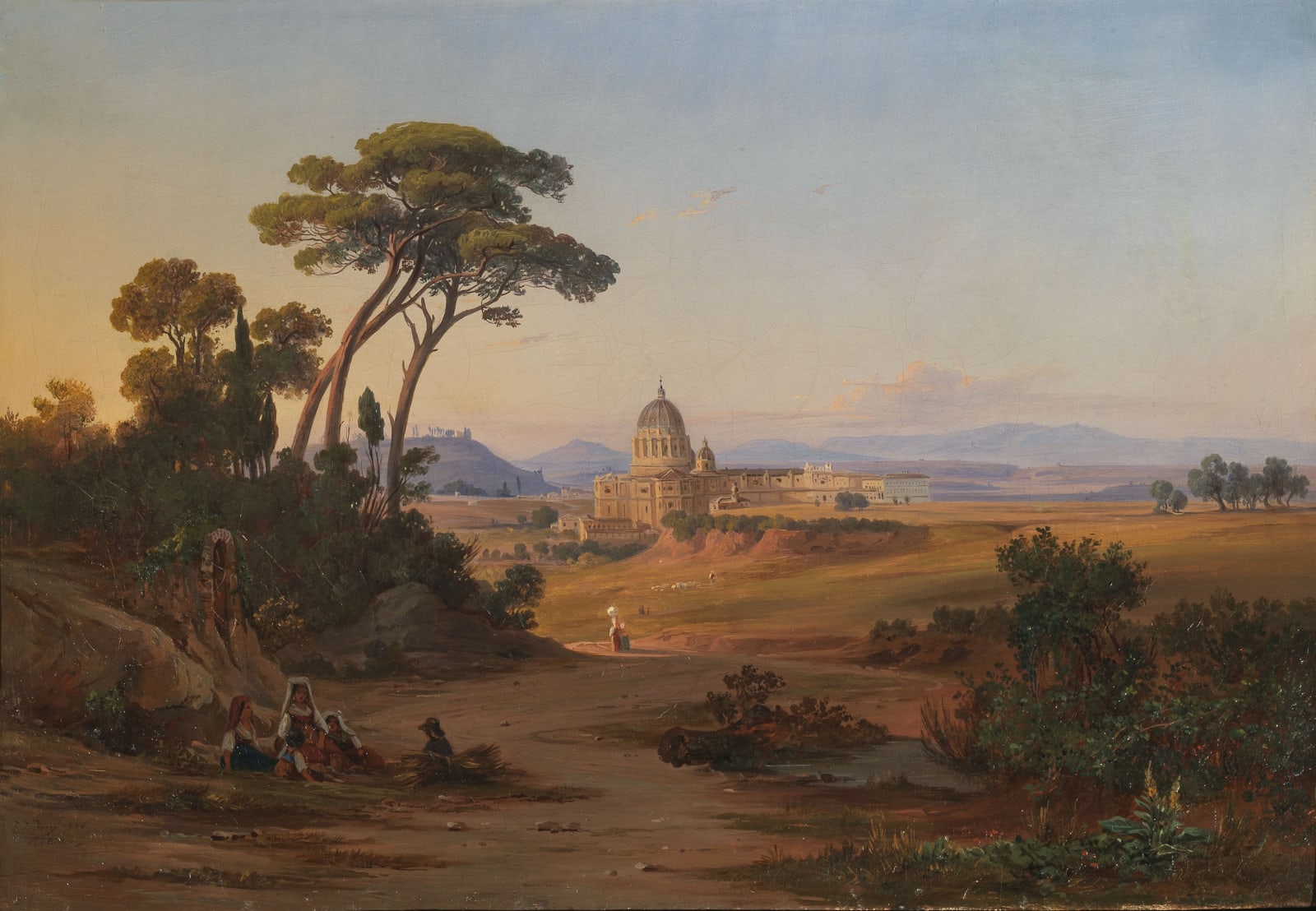Johann Jakob FREY 1813-1865
The painting depicts a view of Saint Peter Church taken from the North of the valle Aurelia. In the foreground can be seen the apse and the “michelangiolesque” dome immersed in the Roman Campagna. Surrounded by mountains, like the Monte Mario on the left, the city of Rome is almost hidden by nature.
Johann Jakob Frey, born in Basel in 1813, receives his first lessons from his father Samuel Frey, a painter and engraver, and from historical painter Hieronymus Hess. As a youth, he goes to Paris where he works as a restorer of antique paintings for art dealers and also as a lithographer, spending most of his time in the Louvre where he copied the Flemish landscape of the sixteenth and seventeenth century. In 1834, after a brief return to Basel, he left for Munich where he was received by his compatriot Emilie Linder, a friend of his master Hess. In 1820 they acquainted themselves with the creative ambient of German artists in Rome: J.A.Koch, J.C.Rheinhart and the group of Nazarenes.
Encouraged by Hess and then with the financial help of Linder, Johann Jakob goes to Rome in 1836 (according to the date marked on some of his drawings, studies of Italian landscapes among the first documented pieces).
His first studio will be in the Palazzo Venezia, at that time the Austrian Academy, and his apartment was in Via S.Isidoro, from where he could easily reach the Caffé Greco, the meeting place of Germanic artists. He begin his summer trips to Naples and Sicily, whilst producing a series of landscapes to be sold mainly to foreign visitors passing through Rome. In 1842, invited by the archaeologist Richard Lepsius, who writes a diary of his travels published in 1849 and 1852, Frey joins the expedition to Egypt and Ethiopia, funded by the Prussian Government. The journey, full of accidents and mishaps, including the loss of many notes and drawings, will be ended by Frey in the summer of 1843, when, for reasons of health, the Swiss painter is forced to return to Rome, where he settles down in Via Capo le Case n.8.
Frey’s eastern experience made his new studio a lively centre for the numerous Swiss artists active in Rome. He excelled among these artists and his success grew.
The commissions, which Frey faithfully recorded in his diary, covering the years 1839 to 1865, were countless. Among the clients that stand out were the German kings (of Bavaria, of Prussia and Württemberg), the English aristocracy (are recorded Lady Windsor, the Marquess of Londonderry and Lord Oxford) as well as several Russians and Americans admirers.
The followed a most difficult period due primarily to the political events of 1848-49 that saw Rome deserted by tourists of rank; however this allowed the painter to embark on fruitful trips to Spain and Switzerland. In 1858 we find Frey established a studio in the ancient and elegant Hotel de Russie at the entrance of via del Babuino. The artist married a Roman girl in 1854; together they had a daughter who will then marry Ettore Ferrari, sculpture and watercolourist, a central figure of late nineteenth-century in the Roman art. Frey will spend the coming years between his home in the city and the peace of his Frascati, “vineyard” where he died, perhaps due to typhoid fever in September 1865.
His remains will be interred in a tomb, beautifully decorated with Egyptian motives in the Porta San Paolo cemetery. His many works, were for his son-in-law, a constant point of reference in developing the kind of vision of the "Roman countryside" that will spread as one of the most valuable aspects of the new naturalistic landscapes at the end of last century. Frey works are preserved in the collections of museums in Basel, Berlin, Gdansk and Leipzig.
JOIN OUR MAILING LIST
Subscribe to our mailing list in order to receive news on new acquisitions, exhibitions, special previews and more!
* denotes required fields
We will process the personal data you have supplied to communicate with you in accordance with our Privacy Policy. You can unsubscribe or change your preferences at any time by clicking the link in our emails.
